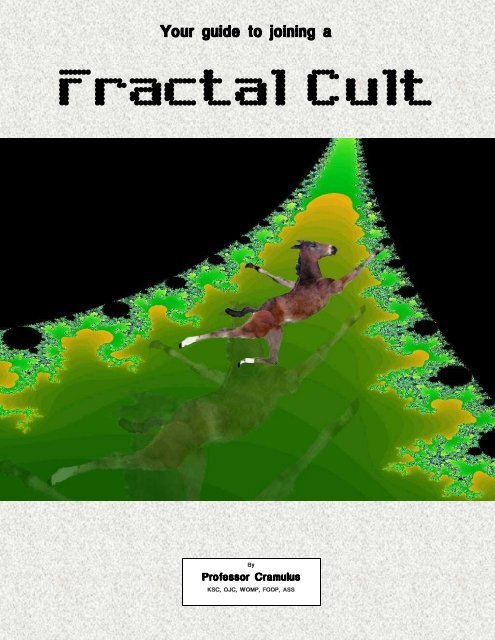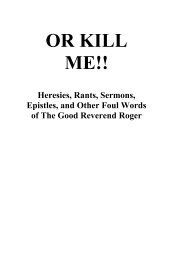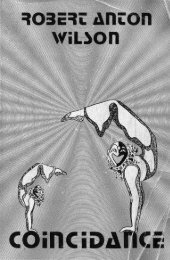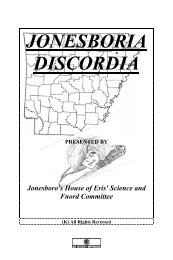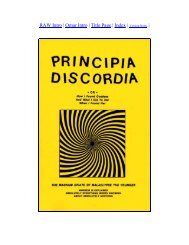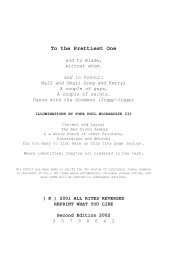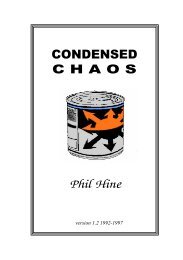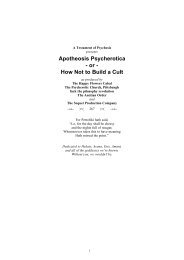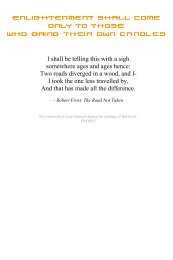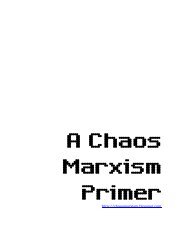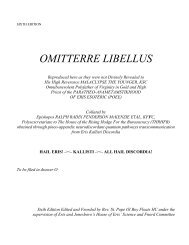Fractal Cult Pamphlet DRAFT 1 - Principia Discordia
Fractal Cult Pamphlet DRAFT 1 - Principia Discordia
Fractal Cult Pamphlet DRAFT 1 - Principia Discordia
You also want an ePaper? Increase the reach of your titles
YUMPU automatically turns print PDFs into web optimized ePapers that Google loves.
Your guide to joining a<br />
<strong>Fractal</strong> <strong>Cult</strong><br />
By<br />
Professor Cramulus<br />
KSC, OJC, WOMP, FOOP, ASS
2<br />
<strong>Fractal</strong> <strong>Cult</strong>
By Professor Cramulus<br />
O<br />
ver time, established symbolism, classical revivalism, or other ancient reconstruction<br />
traditions seem less and less useful for describing our strange postmodern<br />
world. Science, religion, and philosophy have been racing for a good model of<br />
the world we live in. We live in a dynamic world of changes and complexity; few symbols<br />
are able to capture that.<br />
To that end we propose the <strong>Fractal</strong>. It is a relatively new concept, coined by Benoît<br />
Mandelbrot in 1975: "Many important ... patterns of Nature are either irregular or<br />
fragmented to such an extreme degree that ... classical geometry ... is hardly of any<br />
help in describing their form. ... I hope to show that it is possible in many cases to<br />
remedy this absence of geometric representation by using a family of shapes I propose<br />
to call fractals..." (Mandelbrot, 1977)<br />
At a glance, an image of a fractal set is very complex. One can see a general shape characterized<br />
by rough, irregular edges. If we zoom in to examine these mysterious borders,<br />
we discover new shapes within them, new truths and nuances that were hidden to us at<br />
the lower levels of magnification. And these truths, upon inspection, are similarly<br />
muddy and complex. But they are familiar to us! They carry a structural-similarity to<br />
their parent shape.<br />
The <strong>Fractal</strong> is one of the only symbols which does not seek to reduce complexity.<br />
Through complexity, many things are hidden from us. But the universe is ultimately<br />
knowable because it is recursive, self-descriptive, it features recurring patterns through<br />
which we can know both the large and the small.<br />
This is the first teaching of the <strong>Fractal</strong> <strong>Cult</strong>.<br />
The universe is infinitely complex, but recursive.<br />
This is why your biological systems are a pretty good description of our society. (Your<br />
circulatory system, for example, has a lot in common with both the transportation system<br />
and the economy.)<br />
You, Einstein, and Jeffery Dahmer have basically the same problems.<br />
This is why it makes sense to talk about organizations with the same language we use to<br />
describe individuals.<br />
The trials you face in day to day life are a synecdoche of the greater spiritual trials you<br />
will face during your life.<br />
This is why you can see the truth in clouds.<br />
3
<strong>Fractal</strong> <strong>Cult</strong><br />
EXPLORATION<br />
Initiates in the <strong>Fractal</strong> <strong>Cult</strong> should download software with which they can explore fractal images.<br />
We recommend Chaos Pro for the novice and Apophysis for the advanced fractalnaut.<br />
We find that the sublime beauty of fractal imagery is the perfect backdrop for contemplation of<br />
many of life's problems.<br />
There is a relationship of structural similarity between the big and the small, the internal and<br />
the external, the past, the present, and the future. The small, mundane problems one faces on a<br />
day to day basis are not isolated from life's greater spiritual trials—they are one and the same.<br />
<strong>Fractal</strong>s remind us that everything we've done or not done, everything we desire or avoid, everything<br />
we've been or will one day be, are all equally important parts of the big picture.<br />
4
By Professor Cramulus<br />
TRANSFER<br />
OF LEARNING<br />
If you already know how to play the saxophone, it's a lot easier to learn to play the trumpet. If<br />
you already speak Spanish, it's easier to learn French. This is called Transfer of Learning,<br />
the ability to use knowledge of one skill when learning another.<br />
If you're learning similar skills, there's a lot you can transfer. If you already know one programming<br />
language, it's much easier to learn others. But your ability to bake a pie does not usually<br />
play a role in that learning.<br />
Psychologists have wondered what if there is a way to amplify the amount of transfer that takes<br />
place. Priming techniques have been somewhat successful - that is, explicitly telling people that<br />
they should draw on existing knowledge. This points their attention to the ways that the thing<br />
they are learning is similar to the things they already know.<br />
In the <strong>Fractal</strong> <strong>Cult</strong>, our thinking is that if ALL IS ONE and AS ABOVE, SO BELOW, we may be<br />
able to transfer skills from very unlikely places.<br />
Improvisation skills learned in drama also apply for living an interesting and engaging life.<br />
There is a link between picking up a girl in a club and trying to sell somebody a mobile phone.<br />
A first date and a job interview are kissing cousins.<br />
Transfer of Learning is made easier by thinking of the universe like a fractal. We are reminded<br />
that no matter what we look at, we are looking at different parts of basically the same shape.<br />
Even though throwing a party and painting a picture are two entirely different activities, one<br />
may still teach you a little bit about the other- They both require a certain aesthetic sensitivity,<br />
an attention towards emotion and experience.<br />
The patience and discipline we learned in school is a source we can tap into when cleaning the<br />
house or fixing a car. Great cooks, writers, and lovers have developed sensitivities and attention<br />
to details that will be useful anywhere else in life, if only they can tap into it.<br />
The <strong>Fractal</strong> <strong>Cult</strong> uses the Fern to represent the idea of relevant structural similarity.<br />
("relevant" being the key word) Each leaf of the fern resembles every other leaf on the fern--<br />
even though they are all unique.<br />
When you are facing a challenge, learning a skill, or confused about something, visualize the<br />
fern. You are this fern frond, and you are growing a new leaf. While the shape of this leaf is<br />
unique, it is also not a new invention; it is a reiteration of something deep within you.<br />
5
<strong>Fractal</strong> <strong>Cult</strong><br />
FIRST<br />
MEDITATION:<br />
THE<br />
UNIVERSE<br />
IS FRACTAL<br />
Ch ao t e Ch ing , Ch ap t er 1 1<br />
T h e M a nd e lbr ot gr ow s in infinit e com p le xit y<br />
ba s e d on t h e e m p t y s p a ce a t it s ce nt e r .<br />
K now le d ge is bu ilt on fa ct s :<br />
A s ca ffold ing t o s u p p or t ignor a nce .<br />
The universe is infinitely complex,<br />
recurring patterns.<br />
T h e line s in a color ing book give t h e p a ge for m<br />
bu t cr a y ons give it life ,<br />
not s t a y ing cons t r a ine d ins id e t h e line s ,<br />
nor r e d u cing t h e p a t t e r n t o s cr ibble s .<br />
but graspable because it contains<br />
Every bit of the big picture<br />
is present<br />
We s t ick a p a r t a nd s t a y ba ffle d ,<br />
y e t k e e p com ing ba ck<br />
t o t h e ve r y s a m e t h ing.<br />
in the most minute detail.<br />
T h e le ns of t h e fir s t m icr os cop e r e ve a le d fr a ct illia n<br />
ignor a nce .<br />
All is one.<br />
Sh a p e d w or d s , u nr a ve le d m e a nings ,<br />
int e r p r e t , cor r u p t , a d a p t or cons t r u e .<br />
We k ne w a ll a long<br />
w or d s d on’t cou nt .<br />
Se e w h a t e xis t s , u s e w h a t d oe s not .<br />
6
By Professor Cramulus<br />
SECOND<br />
MEDITATION:<br />
COMPLEXITY<br />
There are no simple answers.<br />
The closer your observe something, the<br />
more complex it becomes.<br />
Try to measure the length of a coastline.<br />
The more accurate ruler you use, the more<br />
detail is revealed, and the longer the coastline<br />
will become.<br />
When we talk about complex things like the<br />
economy, we are only capable of describing<br />
it by generalizing, by observing recurring<br />
patterns. Even economists do not understand<br />
it.<br />
All truths contain caveats and footnotes, inconsistencies<br />
that are hidden as soon as we view<br />
them with confidence and certainty.<br />
To be comfortable with complexity, we must accept<br />
that what we understand contains things<br />
we do not understand. We must not be certain,<br />
firm, or unyielding.<br />
We can only know the world using human tools.<br />
These tools contain our flaws and biases.<br />
7
<strong>Fractal</strong> <strong>Cult</strong><br />
THIRD<br />
MEDITATION:<br />
AS ABOVE, , SO BELOW<br />
, S<br />
Structural similarities appear regardless of scale. The big picture can be observed in<br />
small things and vice versa.<br />
Our existence is the sum of numerous interrelated individuals called cells. Cells are organized<br />
into tissue, tissue is organized into organs, all have their own jobs and ecosystems<br />
and motivations and are essential players in the fate of the individual.<br />
Likewise we humans organize ourselves into networks of varying scale: interest<br />
groups, families, corporations, religions, nations... We have built a society which looks<br />
like us. There is a large branching infrastructure designed to carry nutrients to small<br />
individual capillaries. As cells die, they are replaced.<br />
In our meditations we can see a greater human super-entity which is composed<br />
of numerous sub entities. Every sub entity, whether it’s a political<br />
party, a PTA meeting, a lone freak, or a cluster of cells within<br />
your body, plays a role in the whole being’s fate.<br />
8
By Professor Cramulus<br />
FOURTH<br />
MEDITATION:<br />
RECURSION<br />
AND REITERATION<br />
At a fixed level of<br />
magnification, the<br />
same pattern can<br />
be observed all<br />
over the place. But<br />
each iteration is<br />
unique.<br />
We compartmentalize<br />
our lives into<br />
different parts.<br />
Your social circle,<br />
your workplace,<br />
your family, your<br />
online identity…<br />
you may seem like<br />
a very different<br />
person depending<br />
on your context.<br />
But you probably<br />
face similar challenges<br />
in each<br />
compartment.<br />
That is because each element of your self is like a fronds on<br />
the same fern.<br />
You must connect the solutions you have found in one<br />
frond to the challenges you face on other fronds. Each<br />
problem will require a unique solution, but bear similarities<br />
to the trials you have already faced.<br />
9
<strong>Fractal</strong> <strong>Cult</strong><br />
TIME<br />
AND MAGNIFICATION<br />
Patterns repeat themselves over time.<br />
There are two dimensions involved in understanding the world as a fractal. The first is the relationship between the macro<br />
and the micro, the recurring patterns which occur in all parts of nature including the social world of humans. The second is<br />
the relationship between past and future, the recurring patterns which occur as a pattern is reiterated over time.<br />
One way of understanding any topic is to diagram its appearance at multiple points in time and levels of magnification.<br />
Biology -> The Self -> Groups of Individuals -> Local Politics -> Global Politics -> The Whole World<br />
Relationships exist between higher and lower levels or organization.<br />
Vocab terms: Iteration. Tessellation. Homology. Homomorphism.<br />
10
By Professor Cramulus<br />
11
12<br />
<strong>Fractal</strong> <strong>Cult</strong>


